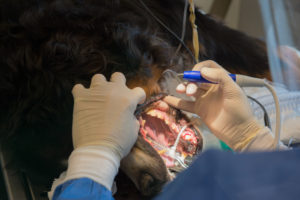 Recently, I saw one of our clients with her seven year- old dog for vaccination and yearly health check.
Recently, I saw one of our clients with her seven year- old dog for vaccination and yearly health check.
During the consultation, she mentioned that the local groomer had cleaned his teeth recently and since then he has developed a reluctance to have his mouth touched.
On limited examination – he only allowed us to lift the front part of his lips, the dental disease was clearly visible, and he also had bad breath. We booked him in for a proper dental cleaning under general anaesthetic a few days later. Under anaesthetic, a thorough assessment of his mouth was possible, and severe dental disease was found. Unfortunately, some teeth needed to be removed as they were not salvageable, and all other teeth were cleaned, polished and rinsed. Before his procedure, he had a pre-anaesthetic blood test, and throughout the surgery, he was supported with iv fluids, full anaesthetic monitoring by a dedicated anaesthetic nurse and surgical monitoring equipment, and pain relief medication. Postoperatively he bounced back very well.
This patient did not present with any problems chewing, and our client was not aware of the severity of his dental disease. This is not unusual, as most dogs and cats continue to eat and drink as normal, even with periodontal disease. The “anaesthesia free” dental cleaning, as offered by the groomer, may have been well intended, but is NOT an appropriate treatment for our dogs and cats.
When we go to the dentist, we are fully aware of what is happening to us. We sit still while the dentist probes and assesses all our teeth, then as we get our dental cleaning done. In some cases (usually when periodontal disease is present) we too need local anaesthetic blocks before treatments.
It is impossible to perform a proper examination, diagnosis and treatment of our pets’ mouth while the pet is conscious. As such, “anaesthesia free” dentals are painful (both physically and emotionally – pets can become very mouth-shy), and risky to pet and the person performing the procedure. It is also ineffective as only the visible tartar is removed but not the tooth root surface under the gums, this is imperative to allow healing of periodontal structures and reversal of dental disease, and bacteria can thus continue to do their damage and even lead to systemic disease.
We do encourage dental home care, including toothbrushing as the gold standard of dental home care; ideally this is done on a daily basis (having it done only when groomed doesn’t have any benefits). Home care options should be started before the painful dental disease has developed, or after we have sanitised the mouth and healing has taken place.
If you are interested in finding out how to brush your pet’s teeth, or to book in for a dental health check-up, please contact our friendly staff at Cronulla Veterinary Clinic on 9527 2604.
